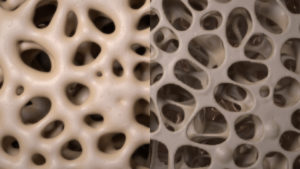
When it comes to Pilates, people often think of building muscles rather than bones. As a number of women and men over the age of 50 are impacted by osteoporosis, we are going to learn more about this disease and the scientific process that occurs in the bones. This will set the foundation for a better understanding of the value of weight bearing exercises and how Pilates offers several advantages in building stronger bones.
Considered the silent disease because it can sneak up without any symptoms until something is broken, osteoporosis is a bone condition that effects anatomically at the deepest layer.
From a cellular level, there are bone building cells called osteoblasts and bone eating cells called osteoclasts. It’s normal to have both kinds of cells. Even the bone-absorbing osteoclasts serve a purpose in repair and regeneration. It’s when the osteoclasts out pace the osteoblasts that the bones can become porous leading to osteopenia and osteoporosis. There are also osteocyte cells that are thought to regulate whether the bone builders or eaters are activated.
When a load is placed on the body, it calls the osteoblasts into action. This is why weight bearing exercises are so important. It stimulates the bone building cells.
Even something as simple as standing is considered “weight bearing”. Interestingly, when astronauts spend time in space, they lose bone density. Gravity helps in bone building as it exerts a pull or load on the body activating the osteoblasts.
A few things to keep in mind about strengthening the bones. One is that building muscle also builds bone. Second, this strengthening is specific, so if you lift arm weights that will build the arm muscles and bones. However, if someone has osteoporosis, she should not lift objects more than 20lbs (and perhaps even 10lbs depending on fragility). Also, good technique is important whenever lifting, whether gym weights or grocery bags.
A strength training regimine is not only recommended to combat osteoporosis but also a walking, balance and spinal extensor program. As posture is often a concern with age, a spinal extension program can have a double benefit of improving posture and building the back bones.
It is important to note that without proper guidance Pilates could be harmful! The classical Pilates matwork consists predominately of spinal flexion exercises which should be avoided by those with osteoporosis. With the right instruction, a Pilates program can safely improve posture, balance, muscle and bone strength.
Pilates has a number of benefits when it comes to bone health. Obviously, the Pilates equipment offers unique resistance, whether small props like the magic circle or large pieces such as the reformer and the cadillac/trapeze table. The spring loaded machines give progressive resistance which means the weight increases the further into the movement. Since Pilates develops the whole body, this strengthens multiple muscle groups and bones.
The standing exercises offer additional weight bearing, not to mention balance opportunities. A focus on good posture and proper form during movement is valuable so the bones are strengthened in good alignment. While spinal flexion should be avoided, Pilates has plenty of beneficial spinal extensor exercises. In the fight against the silent disease of osteoporosis, Pilates builds not only muscle but can also build strength down to the bone.
